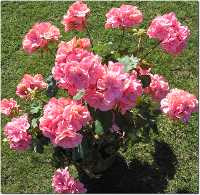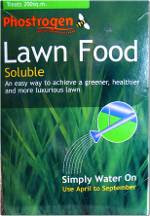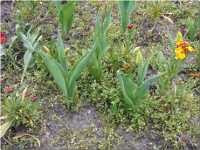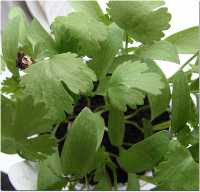BEDS AND BORDERSNon-chemical controlAsk most people how they weed their garden and they will tell you they wait until the last moment (until the weeds are full of seeds), then get down on their knees, usually on wet ground, and dig into the soil surface around the weeds with a hand fork. Having loosened the soil, they proceed to pull out the weeds by hand.
I have tried for years to tell people that not only is this the most laborious and time-consuming method, it is also very inefficient. Needless to say, my efforts have been in vain. They carry on with the same technique. It's as if they need to suffer to feel worth their stripes; they just could not live with themselves if they didn't suffer.
So, in case what I am about to reveal falls once more on deaf ears, I want you to know that I understand. Nevertheless, I am going to tell you anyway:

This implement is called a 'Dutch' or a 'D' hoe. As far as I am concerned, it could be the most valuable tool in any garden tool shed (Yes, I know it doesn't look very valuable, but hear me out).
Hand forks are useful in that they loosen the soil, thereby not only allowing weeds to be removed more easily, but also causing the surface layer to dry out. This drying starves young weeds of vital moisture down to a depth of upto 10 centimetres (4 inches), which slows down growth. Add this to the fact that the soil looks more attractive after weeding, and it has to be said that it is not all bad for this method.
As far as I am concerned, the problems are really five-fold:
Firstly, too much loosening causes unnecessary water loss from the soil, depriving not just the weeds but also our plants. And of course, because young weeds can usually survive with less water than our cultivated plants, this process actually favours weed production (especially if the weeds have ripe seedheads. A new crop of weeds is planted as the old ones are handled).
Secondly, deep digging often disturbs the roots of our valuable plants.
Thirdly, valuable top soil clinging to the roots of the weeds is lost, unless these weeds are recycled through home-made compost.
Fourthly, digging brings up old weed seeds which have been buried too deep to germinate.
Fifthly, digging with a hand fork does little to kill those weeds too small to be pulled (and sometimes seen). All it really does is move them around, and slow down the growth process a little due to reduced water availability.
Consequently, weeding this way becomes a never-ending (and dreaded) task, which might need repeating at weekly, or even daily, intervals.
WELCOME TO THE NINETEENTH CENTURY!
I don't know exactly when the 'Dutch' hoe was invented. I am supposing it must have been around since the Industrial Revolution. It has been used extensively in horticulture ever since.
A 'Dutch' hoe can be skimmed back and fore at varying heights beneath the soil surface. Using it just beneath the soil surface cuts through most weed stems between the root and the soil surface.
With annual weeds, regeneration is impossible. The root will die back into the soil.
With perennial weeds, whose roots store food, they might throw up new growth, but any food reserves will soon be depleted and persistent treatment will kill the young weeds. Older weeds will also be weakened and eventually die off (I sometimes help them along with a little Glyphosate weedkiller applied with a hand spray).
DISADVANTAGESThis technique can be a bit strenuous first time, especially if the soil has become really compacted. But it will be much much easier next time.
It does tend to leave either a flaky or dry powdery surface. But this is ideal for conserving water and deterring slugs.
It is possible to acidentally chop through the stems of our dearly beloveds. But a narrow 10 centimetre (4 inch) blade helps avoid this. I find that this size of blade will remove most weeds in my garden. Yes, it may not get to all the weeds; but nothing is perfect, is it?
TIME SAVINGThe time saved versus the hand digging method is absolutely colossal. Once you have the weeds under control, any garden can be quickly skimmed over. A job that might have taken hours can be done literally in minutes - and far more efficiently!
LABOUR SAVINGThere is no need to bend down. Small weeds will quickly shrivel to nothing if left on the surface on a dry day. This method might look a bit unsightly at first, but if you come back the next day, it should be hard to find any dead weeds. I don't know where they go to. This is one of those eternal mysteries of this world. But go they do.
WATER SAVINGThis technique is especially beneficial for water conservation, particularly around young plants with immature root systems.
WEATHER CONDITIONSAlthough best done on a dry sunny day, it is effective in any weather.
What are you waiting for? Now is the time to get on top of weeds, before they become too established and shed seeds. Get out there and start hoeing!
 This geranium (pelargonium) will soon be in full bloom. It is the same plant we watered earlier. I have left the old dying leaves on.
This geranium (pelargonium) will soon be in full bloom. It is the same plant we watered earlier. I have left the old dying leaves on.































